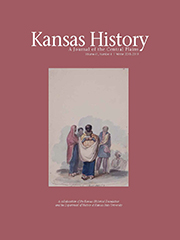February 26, 2019
Winter publication of Kansas History: A Journal of the Central Plains now available

The winter issue of Kansas History: A Journal of the Central Plains has been published through a partnership between the Kansas Historical Foundation and the history department at Kansas State University.
To get a copy, visit k-state.edu/history/kansas-history/ and subscribe today.
In the new issue:
Garrett Wright, "'To the Other Side of the Sun': Indigenous Diplomacy and Power in the Mid-Continent." In 1725, Mitchigamea, Otoe, Missouria and Osage ambassadors traveled across the Atlantic empire to France, where they met with Company of the Indies officials and secured an audience with King Louis XV himself. The delegation was funded and facilitated by French imperial officials, who recognized that the survival and profitability of their American colonies hinged upon alliances with Native nations near French settlements. Company officials hoped that a trip to the center of the French empire might demonstrate to these Native diplomats the utility of the French as allies. The ambassadors themselves — Chicagou (Mitchigamea), Ignon Ouaconisen (Missouria), Mensperé (Missouria), Aguiguida (Otoe) and Boganienhen (Osage) — endured the arduous journey across the Atlantic as representatives of their respective nations. As such, argues historian Wright, they used their time in France to outline their expectations of the French as allies and neighbors. Ultimately, the delegation was successful for all involved parties. "To the Other Side of the Sun" situates this diplomatic delegation within its North American context, highlighting the power of the Native nations represented in France and the importance of alliances with Native nations to the French imperial enterprise.
Bonnie Lynn-Sherow, "Exercising the Pencil: George Winter and the Potawatomis' Removal to Kansas." The legacy of the Potawatomis who live in Kansas today did not begin with their arrival in the territory but rather unfolded over time and amidst changing circumstances elsewhere to the east. Unlike other tribes, the Potawatomis and their neighbors the Miamis had a keen observer and chronicler in the artist George Winter. His artistic renderings surrounding the 1837 Logansport, Indiana, removal period provide an intimate window into an exceptional moment in Kansas Indian history.
Margaret C. Wood, Christine D. Garst, Robert J. Hoard and Virginia A. Wulfkuhle, "The Thomas Johnson and Henry Williams Farmstead: A Rural Component of the Nineteenth-Century Settlement of Nicodemus, Kansas." The predominantly African American agricultural community of Nicodemus was established in 1877 in Graham County, Kansas. Thomas and Zerina Johnson homesteaded property northeast of town, and generations of their descendants made a living on that land, despite challenges of nature, geography, isolation, and racial prejudice. In 2006 and 2007, archaeologists and historians collaborated on a study of the Thomas Johnson/Henry Williams farmstead. A dugout/sod-up residence, a dugout cellar, and a trash dump were excavated, and artifacts were collected and analyzed, revealing details of the daily lives of a black farm family who sought social and economic opportunities in western Kansas in the late 19th and early 20th century.
